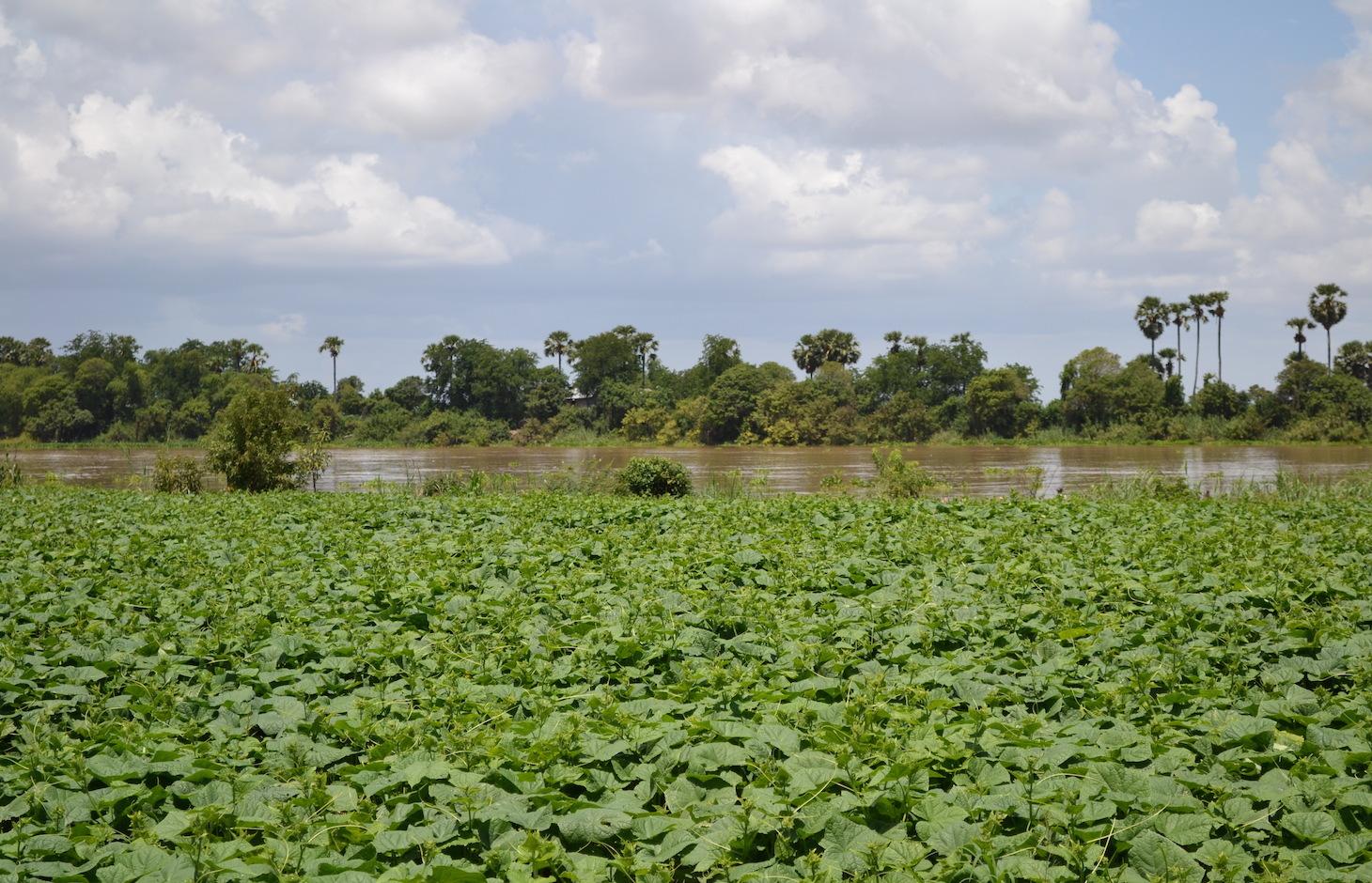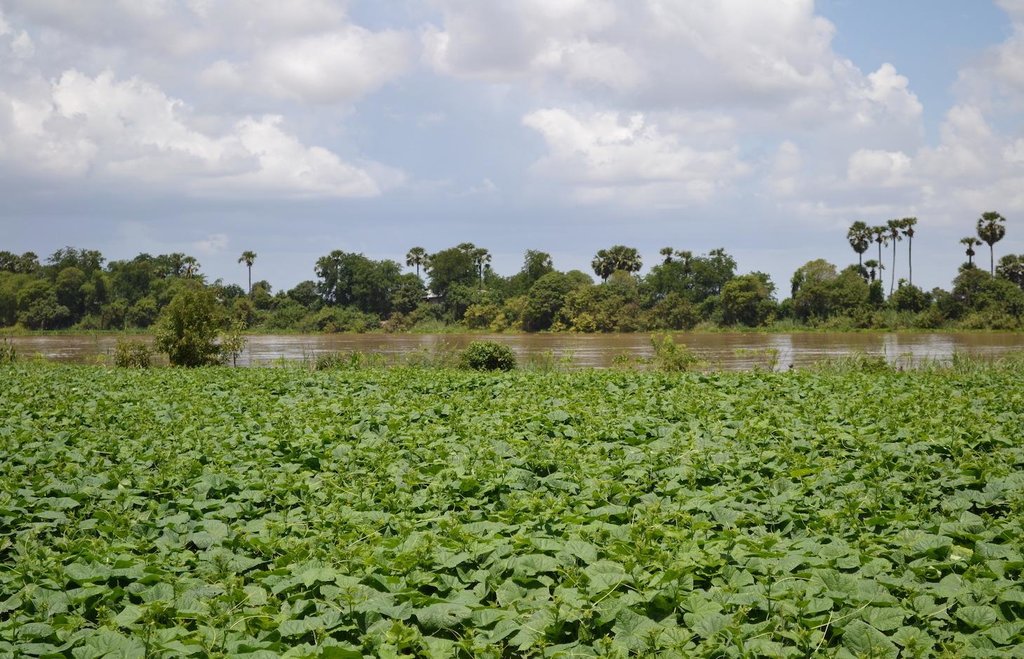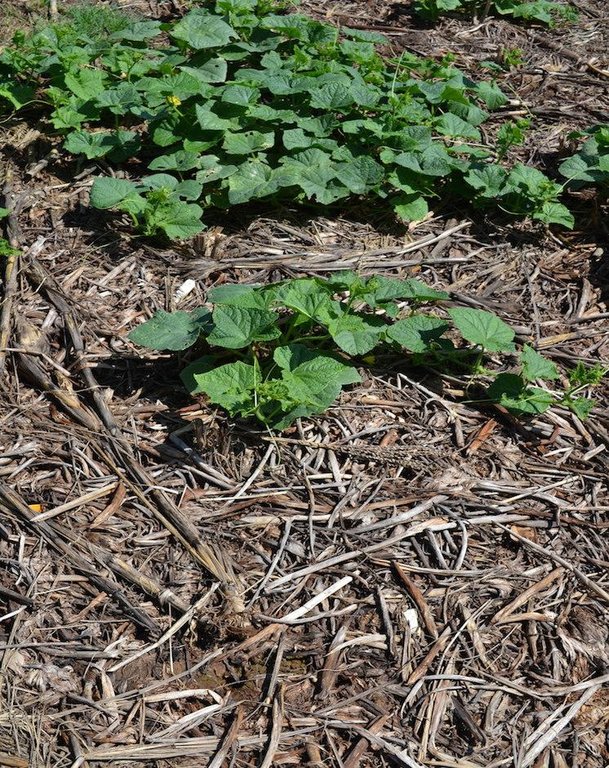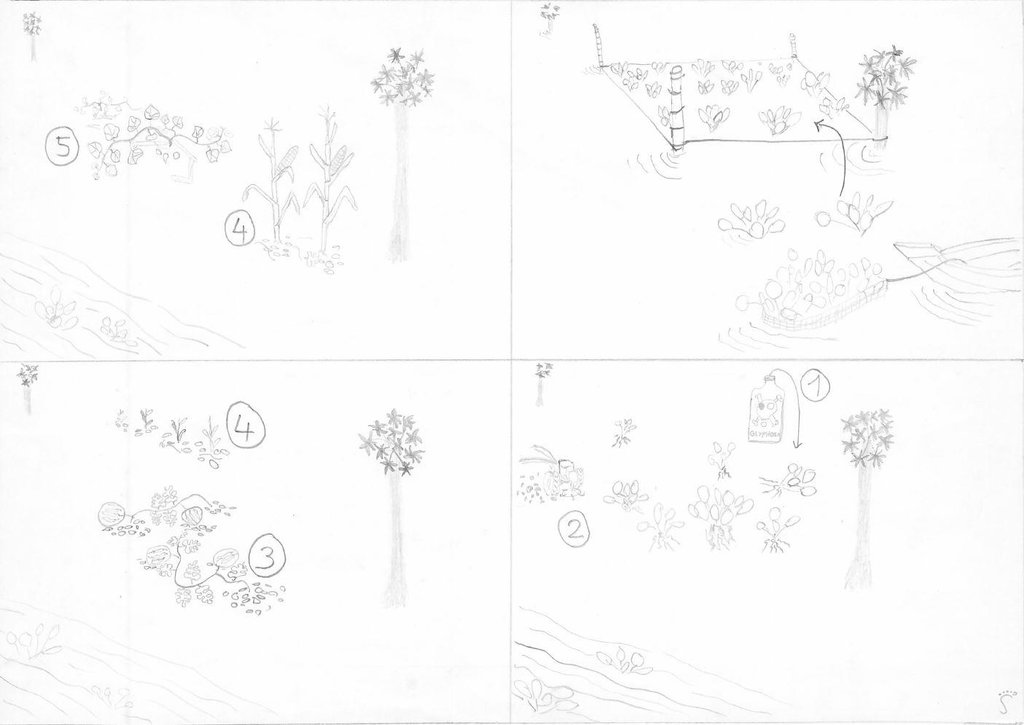Mulching with water hyacinth (Eichhornia crassipes) after the monsoon floods. [Cambodia]
- Creation:
- Update:
- Compiler: Christoph Kaufmann
- Editor: –
- Reviewers: Deborah Niggli, Alexandra Gavilano
ការប្រើប្រាស់កំប្លោកជាគម្របដីដំាដំណំាក្រោយពេលទឹកសម្រក (Khmer)
technologies_1223 - Cambodia
View sections
Expand all Collapse all1. General information
1.2 Contact details of resource persons and institutions involved in the assessment and documentation of the Technology
SLM specialist:
Khun Lean Hak
Cambodia
1.3 Conditions regarding the use of data documented through WOCAT
The compiler and key resource person(s) accept the conditions regarding the use of data documented through WOCAT:
Yes
1.4 Declaration on sustainability of the described Technology
Is the Technology described here problematic with regard to land degradation, so that it cannot be declared a sustainable land management technology?
No
1.5 Reference to Questionnaire(s) on SLM Approaches (documented using WOCAT)

Model farmer [Cambodia]
Model farms were introduced by a NGO in order to spread knowledge about SLM (compost, System of Rice Intensification SRI, and other technologies) in the project area.
- Compiler: Christoph Kaufmann
2. Description of the SLM Technology
2.1 Short description of the Technology
Definition of the Technology:
Water hyacinth (Eichhornia crassipes) is collected during the monsoon floods, attached to poles on the flooded fields, chopped when the water recedes and used as mulch to plant different crops.
2.2 Detailed description of the Technology
Description:
This mulching technique is used at the riverside of the Tonle Sap River. The area is flooded during the late rainy season (September to November), and alluvial mud is deposed on the fields, which enhances the soil fertility. The deposition of sediments depends on the extent of the yearly flood, and is threatened by the construction of hydropower dams on the upper Mekong River (Thomas et al. 2012:49), as well as climate change (floods tend to be smaller or more extreme). During the dry season (approximately from January to June, depending on precipitation patterns) the land dries and due to high temperatures and very low precipitations, crops can be harmed.
At first, the farmer gathers the water hyacinth with his boat during the wet season. He surrounds them with a net and pulls them to his fields, where he prepares fences with bamboo poles and iron wires. He fills the fenced area with the water hyacinth. Once the water recedes, he sprays glyphosate on the water hyacinths and chops them by using a hand tractor. He plants his first crop, watermelon, as soon as the soil is dry enough (start of dry season). The crop residues of the watermelon are left on the fields, and he can plant a crop of corn and a crop of cucumber before the next flood enters.
The analyzed area is flat (slope < 2%), tropic (dry and wet season), and the soils are mostly loamy. The groundwater table is rather high with 1-2 m during the dry season (November to May). The area is flooded during and after the wet season (August-September to November). The floods bring sludge and thus nutrients to the fields.
Due to climate change, the rainfalls are more erratic, temperatures rise and droughts are more recurrent. Chili is the cash crop predominantly grown in the flooded area, with floating rice as second crop.
Agricultural activity in this region is confronted with high migration rates (garment industry, cities, or other countries). This is detrimental for the farmers, since there is less labour force available. Also, the presented technology requires a rather high initial investment (especially when a tractor is bought) and an increase of physically strenuous labour. Therefore, the interviewed land user stated that most farmers are reluctant to do high investments on their farm. This is aggravated due to the fact that taking up credits might increase the dependency of the farmer.
2.3 Photos of the Technology
2.5 Country/ region/ locations where the Technology has been applied and which are covered by this assessment
Country:
Cambodia
Region/ State/ Province:
Kampong Chhnang
Further specification of location:
Kampong Os
Specify the spread of the Technology:
- evenly spread over an area
If the Technology is evenly spread over an area, specify area covered (in km2):
0.02
If precise area is not known, indicate approximate area covered:
- < 0.1 km2 (10 ha)
Comments:
Total area covered by the SLM Technology is 0.02 km2.
2.6 Date of implementation
If precise year is not known, indicate approximate date:
- less than 10 years ago (recently)
2.7 Introduction of the Technology
Specify how the Technology was introduced:
- through projects/ external interventions
Comments (type of project, etc.):
2010 through SOFDEC
3. Classification of the SLM Technology
3.1 Main purpose(s) of the Technology
- improve production
- reduce, prevent, restore land degradation
3.2 Current land use type(s) where the Technology is applied

Cropland
- Annual cropping
Annual cropping - Specify crops:
- cereals - maize
- vegetables - melon, pumpkin, squash or gourd
- cucumber
Number of growing seasons per year:
- 1
Specify:
Longest growing period in days: 225, Longest growing period from month to month: Mid-December to end of July
Is crop rotation practiced?
Yes
If yes, specify:
He plants his first crop, watermelon, as soon as the soil is dry enough (start of dry season). The crop residues of the watermelon are left on the fields, and he can plant a crop of corn and a crop of cucumber before the next flood enters.
Comments:
Major land use problems (compiler’s opinion): Regular flooding, use of pesticides, low soil organic matter, monocultures.
Major land use problems (land users’ perception): Pumping machines and tubes to irrigate are not easily available. High irrigation need as the soil organic matter content is low.
3.4 Water supply
Water supply for the land on which the Technology is applied:
- mixed rainfed-irrigated
3.5 SLM group to which the Technology belongs
- improved ground/ vegetation cover
3.6 SLM measures comprising the Technology

agronomic measures
- A1: Vegetation/ soil cover
- A2: Organic matter/ soil fertility
- A3: Soil surface treatment
Comments:
Type of agronomic measures: mulching, minimum tillage
3.7 Main types of land degradation addressed by the Technology

chemical soil deterioration
- Cn: fertility decline and reduced organic matter content (not caused by erosion)

biological degradation
- Bq: quantity/ biomass decline
- Bl: loss of soil life

water degradation
- Ha: aridification
Comments:
Main causes of degradation: soil management (Soil is left bare (not covered) in other cultivations), education, access to knowledge and support services (People don’t know about cover crops, or are afraid of the initial costs of machinery)
Secondary causes of degradation: crop management (annual, perennial, tree/shrub) (Only annuals are planted, soil is otherwise left bare. But many perennials cannot grow because of the yearly floods), change in temperature (Climate change causes higher evaporation because of higher temperatures.), labour availability (Innovations are becoming more risky as labour availability is decreasing)
3.8 Prevention, reduction, or restoration of land degradation
Specify the goal of the Technology with regard to land degradation:
- prevent land degradation
4. Technical specifications, implementation activities, inputs, and costs
4.1 Technical drawing of the Technology
Technical specifications (related to technical drawing):
Top Right: during the flooded season, water hyacinths are gathered and attached over the fields.
Bottom right: after the floods, the water hyacinths are killed with herbicides (1) and chopped with a hand tractor (2).
Bottom and top left: Different crops follow each other, in this case water melon (3), corn (4) and cucumber (5). The crop residues are always left on the fields.
Kampong Chhnang
Date: 2014
Technical knowledge required for field staff / advisors: moderate
Technical knowledge required for land users: moderate
Main technical functions: improvement of ground cover, increase in organic matter, increase / maintain water stored in soil
Secondary technical functions: control of raindrop splash, improvement of surface structure (crusting, sealing), increase in nutrient availability (supply, recycling,…)
Mulching
Material/ species: Water hyacinths
Quantity/ density: n/a
Remarks: As much as the land user can keep with the bamboo poles and wires.
Minimum tillage
Quantity/ density: n/a
Remarks: Sometimes, the land user tills before the yearly floods due to time issues.
Author:
Stefan Graf, Switzerland
4.2 General information regarding the calculation of inputs and costs
Indicate average wage cost of hired labour per day:
5.00
4.4 Costs and inputs needed for establishment
| Specify input | Unit | Quantity | Costs per Unit | Total costs per input | % of costs borne by land users | |
|---|---|---|---|---|---|---|
| Equipment | tools | ha | 1.0 | 130.0 | 130.0 | 100.0 |
| Equipment | boat | ha | 1.0 | 1000.0 | 1000.0 | 100.0 |
| Equipment | hand tractor | ha | 1.0 | 1500.0 | 1500.0 | 100.0 |
| Fertilizers and biocides | biocides | ha | 1.0 | 4.5 | 4.5 | 100.0 |
| Construction material | wires and bamboo poles | ha | 1.0 | 30.0 | 30.0 | 100.0 |
| Total costs for establishment of the Technology | 2664.5 | |||||
| Total costs for establishment of the Technology in USD | 2664.5 | |||||
4.5 Maintenance/ recurrent activities
| Activity | Timing/ frequency | |
|---|---|---|
| 1. | Collecting water hyacinth and put poles | During the floods each year (Oct-Nov) |
| 2. | Spraying herbicide on the water hyacinth | After floods |
| 3. | Chopping the sprayed water hyacinth with the hand tractor | After spraying herbicide |
4.6 Costs and inputs needed for maintenance/ recurrent activities (per year)
| Specify input | Unit | Quantity | Costs per Unit | Total costs per input | % of costs borne by land users | |
|---|---|---|---|---|---|---|
| Labour | labour | ha | 1.0 | 35.0 | 35.0 | 100.0 |
| Equipment | machine use | ha | 1.0 | 10.0 | 10.0 | 100.0 |
| Total costs for maintenance of the Technology | 45.0 | |||||
| Total costs for maintenance of the Technology in USD | 45.0 | |||||
Comments:
Machinery/ tools: Hand tractor with a chopper
The costs were calculated per ha, in 2014. There is only one farmer (2 ha) next to the Tonle Sap applying this technology.
4.7 Most important factors affecting the costs
Describe the most determinate factors affecting the costs:
The factor affecting the costs the most is the availability of cheap equipment. For the recurrent activities the labour costs were calculated as if he hired someone, but he does all by himself. The work is strenuous, as he has to walk in water and trough the water hyacinths.
5. Natural and human environment
5.1 Climate
Annual rainfall
- < 250 mm
- 251-500 mm
- 501-750 mm
- 751-1,000 mm
- 1,001-1,500 mm
- 1,501-2,000 mm
- 2,001-3,000 mm
- 3,001-4,000 mm
- > 4,000 mm
Agro-climatic zone
- sub-humid
Thermal climate class: tropics. 27-35°C
5.2 Topography
Slopes on average:
- flat (0-2%)
- gentle (3-5%)
- moderate (6-10%)
- rolling (11-15%)
- hilly (16-30%)
- steep (31-60%)
- very steep (>60%)
Landforms:
- plateau/plains
- ridges
- mountain slopes
- hill slopes
- footslopes
- valley floors
Altitudinal zone:
- 0-100 m a.s.l.
- 101-500 m a.s.l.
- 501-1,000 m a.s.l.
- 1,001-1,500 m a.s.l.
- 1,501-2,000 m a.s.l.
- 2,001-2,500 m a.s.l.
- 2,501-3,000 m a.s.l.
- 3,001-4,000 m a.s.l.
- > 4,000 m a.s.l.
5.3 Soils
Soil depth on average:
- very shallow (0-20 cm)
- shallow (21-50 cm)
- moderately deep (51-80 cm)
- deep (81-120 cm)
- very deep (> 120 cm)
Soil texture (topsoil):
- fine/ heavy (clay)
Topsoil organic matter:
- high (>3%)
5.4 Water availability and quality
Ground water table:
on surface
Availability of surface water:
excess
Water quality (untreated):
poor drinking water (treatment required)
Comments and further specifications on water quality and quantity:
Ground water table: during wet season
Availability of surface water: during wet season
5.5 Biodiversity
Species diversity:
- low
5.6 Characteristics of land users applying the Technology
Market orientation of production system:
- commercial/ market
Off-farm income:
- 10-50% of all income
Relative level of wealth:
- average
Individuals or groups:
- individual/ household
Level of mechanization:
- manual work
- mechanized/ motorized
Gender:
- men
Indicate other relevant characteristics of the land users:
Land users applying the Technology are mainly common / average land users
Difference in the involvement of women and men: The labor is strenuous and is therefore mainly done by males. However, the interviewed land user is so far the only one applying this technology in the area.
Population density: 10-50 persons/km2
Annual population growth: 0.5% - 1%
Off-farm income specification: Wife owns a little coffee shop.
5.7 Average area of land used by land users applying the Technology
- < 0.5 ha
- 0.5-1 ha
- 1-2 ha
- 2-5 ha
- 5-15 ha
- 15-50 ha
- 50-100 ha
- 100-500 ha
- 500-1,000 ha
- 1,000-10,000 ha
- > 10,000 ha
Is this considered small-, medium- or large-scale (referring to local context)?
- medium-scale
5.8 Land ownership, land use rights, and water use rights
Land ownership:
- communal/ village
- individual, not titled
Land use rights:
- leased
- individual
Water use rights:
- open access (unorganized)
Comments:
Many land users have a land title that is not recognized by the state.
5.9 Access to services and infrastructure
health:
- poor
- moderate
- good
education:
- poor
- moderate
- good
technical assistance:
- poor
- moderate
- good
employment (e.g. off-farm):
- poor
- moderate
- good
markets:
- poor
- moderate
- good
energy:
- poor
- moderate
- good
roads and transport:
- poor
- moderate
- good
drinking water and sanitation:
- poor
- moderate
- good
financial services:
- poor
- moderate
- good
6. Impacts and concluding statements
6.1 On-site impacts the Technology has shown
Socio-economic impacts
Production
crop production
Quantity before SLM:
50
Quantity after SLM:
100
Comments/ specify:
According to the farmer the yield doubled.
product diversity
Comments/ specify:
Grows other cash crops than the other farmers in the area.
Water availability and quality
demand for irrigation water
Income and costs
expenses on agricultural inputs
workload
Comments/ specify:
However, there is less irrigation work needed.
Socio-cultural impacts
conflict mitigation
Ecological impacts
Water cycle/ runoff
water quality
Comments/ specify:
Herbicide is used in the river.
evaporation
Soil
soil moisture
soil cover
nutrient cycling/ recharge
soil organic matter/ below ground C
Biodiversity: vegetation, animals
pest/ disease control
Comments/ specify:
Problems with insects
6.2 Off-site impacts the Technology has shown
groundwater/ river pollution
Comments/ specify:
Herbicide goes into the river
6.3 Exposure and sensitivity of the Technology to gradual climate change and climate-related extremes/ disasters (as perceived by land users)
Gradual climate change
Gradual climate change
| Season | increase or decrease | How does the Technology cope with it? | |
|---|---|---|---|
| annual temperature | increase | well |
Climate-related extremes (disasters)
Meteorological disasters
| How does the Technology cope with it? | |
|---|---|
| local rainstorm | well |
| local windstorm | well |
Climatological disasters
| How does the Technology cope with it? | |
|---|---|
| drought | well |
Hydrological disasters
| How does the Technology cope with it? | |
|---|---|
| general (river) flood | not well |
Other climate-related consequences
Other climate-related consequences
| How does the Technology cope with it? | |
|---|---|
| reduced growing period | well |
Comments:
The mulch would be carried away in case of extreme floods, but the technology is dependent on the yearly flood
6.4 Cost-benefit analysis
How do the benefits compare with the establishment costs (from land users’ perspective)?
Short-term returns:
very negative
Long-term returns:
very positive
How do the benefits compare with the maintenance/ recurrent costs (from land users' perspective)?
Short-term returns:
very positive
Long-term returns:
very positive
Comments:
A hand tractor could be rented instead of bought
6.5 Adoption of the Technology
Comments:
100% of land user families have adopted the Technology with external material support
1 land user families have adopted the Technology with external material support
The land user received the money from banks, micro-finance institutes and NGOs. Farmers are afraid of the investment costs. Farmers are afraid of the investment costs and the increased workload.
6.7 Strengths/ advantages/ opportunities of the Technology
| Strengths/ advantages/ opportunities in the land user’s view |
|---|
| It is easy to keep the water hyacinth on the fields after the floods |
| The soil keeps the water, less loss due to evaporation. He uses less water for irrigation |
| The plants grow better and have higher yields |
| Strengths/ advantages/ opportunities in the compiler’s or other key resource person’s view |
|---|
| The soil is covered, so it needs less irrigation. |
| The land user needs less fertilizer as the soil fertility, biological activity and carbon content is higher. |
6.8 Weaknesses/ disadvantages/ risks of the Technology and ways of overcoming them
| Weaknesses/ disadvantages/ risks in the land user’s view | How can they be overcome? |
|---|---|
| The profit is not in relation to the work. | Plant more profitable cash crops; share the machines with other farmers. |
| The soil is too wet after the floods because the mulch stops the evaporation. | Grow a water loving plant as first cash crop. |
| Only physically strong people can do the work. | Build simplified water hyacinth harvesting structures. |
| Weaknesses/ disadvantages/ risks in the compiler’s or other key resource person’s view | How can they be overcome? |
|---|---|
| Herbicides are used in an aquatic environment. | Find a chopping device that is sufficient to kill the water hyacinth on its own. |
| The initial investments are high. | Tractor bank could be implemented (share the cost of the machines amongst members.) |
7. References and links
7.1 Methods/ sources of information
- field visits, field surveys
- interviews with land users
When were the data compiled (in the field)?
30/06/2014
7.2 References to available publications
Title, author, year, ISBN:
Thomas, T.S., Ponlok, T., Bansok, R., et al. 2012. Cambodian Agriculture: Adaptation to Climate Change Impacts. A Report for USAID.
Available from where? Costs?
cgiar.org; free
Links and modules
Expand all Collapse allLinks

Model farmer [Cambodia]
Model farms were introduced by a NGO in order to spread knowledge about SLM (compost, System of Rice Intensification SRI, and other technologies) in the project area.
- Compiler: Christoph Kaufmann
Modules
No modules





